Comprisation PART THREE
Alchemy of Order
April, 2024

Previously on Comprisation...
In Part One we associated Alchemy with Geometry, and connected the search for the Philosopher's Stone with Newton's Laws of Motion. We also demonstrated how Comprisational challenges required an understanding of Symmetrical Patterns. And swapping planetary symbols for letters revealed a connection between these patterns and Newton's alchemical archive.
In Part Two we introduced reasons why information would be Occult, and separated "the hidden" from mystical requirements. The Laws of Nature were Occult until revealed though Scientific discovery. We also briefly looked at the history of the atom. Recognized as an irreducible element by Ancient Greece, it has transformed into the Quantum Model of today.
Coincidence is Not Causality. Usually.
The "Doctrine of Signatures" was another "As Above, So Below" belief that said God formed plants in specific shapes, indicating their curative effects. He marked them with a "signature" as to their (human-centric) purpose. An example was "walnuts are curative for the brain," because the shape of the inner nut has convolutions like a brain. Today we recognize the omega-3 fatty acids in walnuts are excellent for brain health, but not as an alternative for treating a brain tumor. Sliced mushrooms resemble a human ear and were thought to cure ear aches. Which is harmless enough, unless the mushrooms are poisonous. Aspirin was discovered based on the location of Willow trees, which grew in a damp environment thought to create certain diseases. Diseases that salicylic acid, distilled from Willow bark, alleviates.

I bring up Doctrine of Signatures to point out that when patterns coincide, that may provide a meaningful path to discovery, or it may just be coincidence.
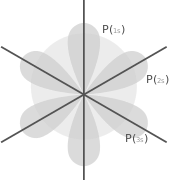
The shape of the Quantum Model Illustration coincidentally reminded me of "The Flower of Life" geometric pattern, which possibly spawned the design of "Metatron's Cube," which Grant is using to analyse Giza, the Pyramid which Newton was trying to measure in the backdrop of my banner image. It's all a lot of coincidence, but probably more fun than populating foursomes. So let's dig in.
Introducing Metatron's Cube
If you come across the name "Metatron's Cube" you will know which side of the Mystical/Objective boundary you are on. Called "Archangel Metatron's" cube, it "represents God's creative energy that flows through the Universe." It is "Sacred Geometry," symbolizing the building blocks of creation in a personal, spiritual healing way. Concentrating on it is said to "push away unwanted energy residue."
Surprisingly, Wikipedia doesn't have an article on Metatron's Cube (MC) and what you find from a Google search is from New Age "Sacred Geometry" sites versus Math or History sources. Wikipedia redirects to "Overlapping circles grid" and in it references "the Flower of Life." I find this interesting as MC is constructed of circles that don't overlap. A New Age site references the non-overlapping configuration as the "Fruit of Life."
Geometry oriented discussions say MC is actually a stellated octahedron, or stella octangula as Johannes Kepler named it.

From Wikipedia:
"Kepler claimed to have had an epiphany on 19 July 1595... he realized that regular polygons bound one inscribed and one circumscribed circle at definite ratios, which, he reasoned, might be the geometrical basis of the universe. He found that each of the five Platonic solids could be inscribed and circumscribed by spherical orbs; nesting these solids, each encased in a sphere, within one another would produce six layers, corresponding to the six known planets—Mercury, Venus, Earth, Mars, Jupiter, and Saturn. By ordering the solids selectively—octahedron, icosahedron, dodecahedron, tetrahedron, cube—Kepler found that the spheres could be placed at intervals corresponding to the relative sizes of each planet's path, assuming the planets circle the Sun."
—Wikipedia, article on Mysterium_Cosmographicum
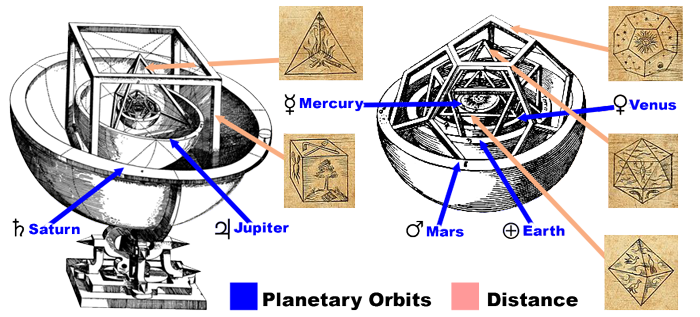
In Kepler's time, men who studied the heavens were from the long tradition of Astrologers. Kepler was one of the first Astronomers, who approached the topic from a mathematical angle, hoping to discover Objective Truth. He played both roles and famously wrote," Astronomy would not provide me with bread if men did not entertain hopes of reading the future in the heavens."
Flower of Life (Overlapping Circles Grid)
Since Metatron's Cube (MC) is called the "Fruit of Life" and fruit comes from the flower, let's take a quick peek at the "Flower of Life" design. It's constructed by overlapping circles, the circumference of each added circle intersecting the center of the previous circe.
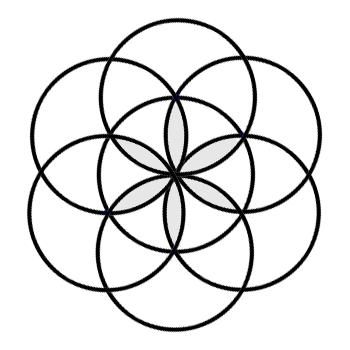

I added grey tint to the "petals" and put the "Quantum Atom" next to it. There is a striking geometric similarity to these images. I didn't find the Quantum illustration in a scientfic paper, so perhaps the Wikipedia artist was inspired by seeing "The Flower of Life"? Was is it just coincidence?
Constructing Metatron's Cube
Metatron's Cube (MC) is a 2 dimensional arrangement of non-overlapping contiguous circle that supposedly serves as a template for creating all the Platonic solids. Kepler illustrated the embedded solids in 3 dimensions above. Fans of MC project them similarly. Let's start simply and see if it works.
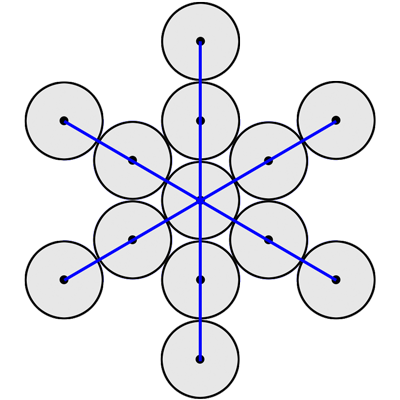
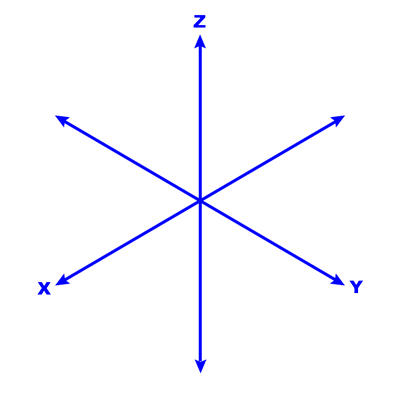
In the beginning we have an origin circle. The next layer out is simple, since each circle touches the origin circle and 2 of its neighbors. Because all the circles are the same diameter, there can only be those 6 in the first layer, and their positions are self organizing. The outer most circles are trickier, as they only touch in one small place. They could easily be out of alignment without the blue axis lines I've added to my construction. The axis lines remind me of the Cartesian coordinate system for three-dimensional space.
Cube (Earth)
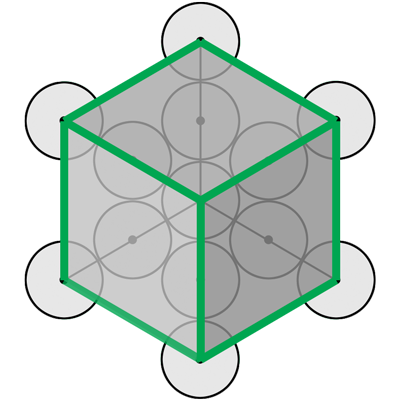

Since it's named "Metatron's Cube" I thought this would be the first of the solids to render. I added shading to help reveal the 3-D nature of the arrangement. My intuition on the Cartesian axes, at least for this shape, turned out correct.
Tetrahedron (Fire)
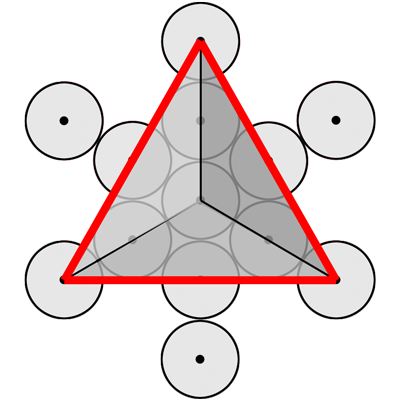

Tetrahedron is sometimes called a 3 sided Pyramid. The Egyptian Pyramid's shape is not one of the Platonic Solids, since the bottom surface is square and not another matching triangle.
Octahedron (Air)
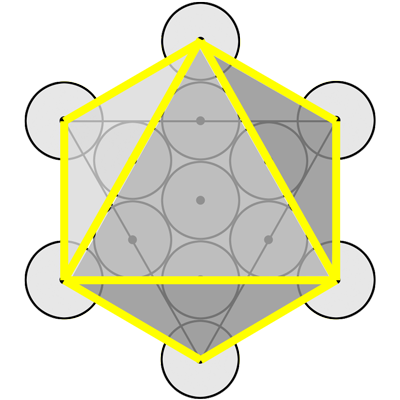

Octahedron is like 2 Pyramids joined at the base. This yields 8 surfaces, all identical triangles.
Icosahedron (Water)
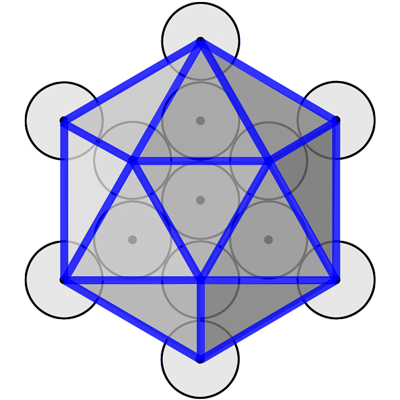

Icosahedron represents an additional splitting into identical triangles. This yields 20 surfaces, 5 around the top, 10 around the middle and 5 around the bottom. It's also the last of the 4 Classic Elements.

In the Timaeus dialogue, Plato lays out a description of the beautiful orderliness of the universe. It is also worth noting, in this dialog he provides an account of the lost civilization of Atlantis.
Meditate on Metatron?
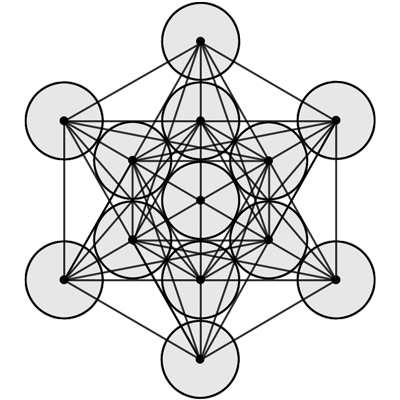
You should also note from the Plato quote that only four of the Solids are mapped to the Classic Elements. Those are constructed above. The fifth Solid is the Dodecaheron, based on repeating pentagons, and not triangles. Aristotle later declared a fifth element, Ether, but did not map it to the dodecahedron. So this shape is the "Black Sheep" of the group. If you are an acolyte of Sacred Geometry you are invited to meditate on the fully connected Metatron's Cube and discover the shape of the dodecahedron within.
False Symmetry
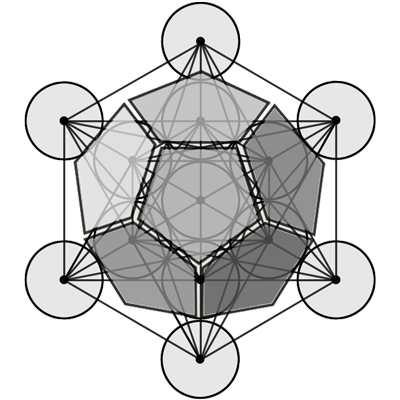
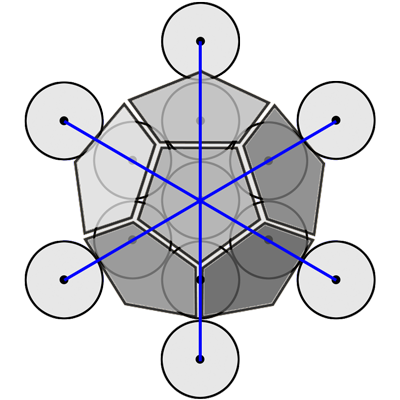
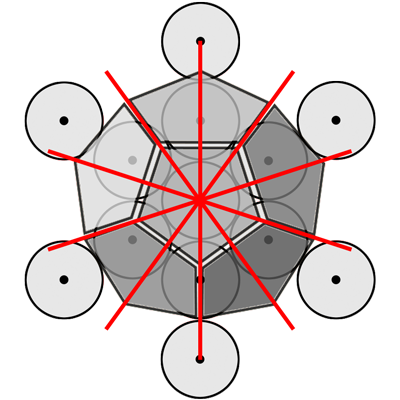
The short answer is that the pentagon is not a shape that maps to the circular arrangement of Metron's Cube. It's a ruse. There are several supposed mappings if you bother to research them. What you will find is people have different dodecahedrons already constructed and then overlay them on a matrix of lines; and they use intersections, half-way points, etc to connected to a distorted projection of a dodecahedron. This is not done with the other four classic solids. The other 4 are all legitimately mapped to the center of the circles.
I only bothered to create images of the overlay myself, because Kepler included the dodecahedron in his Mysterium Cosmographicum as the distance between Earth and Mars. To create the overlap image I traced his orthogonal illustration from Harmonices Mundi. By adding blue axes to the middle illustration, the lines match the circles and assist with the illusion that maybe it works. The far right image presents red lines, which honor 5 sided symmetry and show how it doesn't match the 6 sided symmetry of the MC foundational circles.
In our comprisation exercise we witnessed how breaking a pattern of symmetry can lead to a dead end. It would be another surprising coincidence if Kepler's inclusion of mismatched symmetry (from 6 to 5 sided between Earth and Mars) hurt his attempt to understand the divine order of the solar system. But in the end Kepler did have to abandon the model he based on the Platonic solids. In doing that he revisited his observations of Mars and discovered that planets had elliptical orbits, the contribution for which he is known today.

In PART FOUR we will temporarily conclude the investigation of Mr. Kepler by noting an interesting (or intentional?) oversight. We will also introduce Herr Leibniz and his "Art of Combinations."